|
Every Tuesday, a new Fermilab Director's Corner appears in Fermilab Today, Fermilab's daily email publication for employees, users and subscribers.
Fermilab Director's Corner Archive – 2010
| Dec. 21, 2010 |
| Holiday cheer |
|
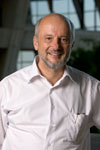 The Fermilab spirit was very much in evidence last Friday. During the afternoon we had a symposium to celebrate the 25th anniversary of the first collisions at the Tevatron. It was an extraordinary experience to hear in one afternoon the rich history of the Tevatron and its many accomplishments. The Tevatron is the pioneering machine, the first large superconducting ring that broke new ground and set the stage for RHIC, HERA and the LHC. Its detectors, CDF and DZERO, are technological marvels and moved forward technologies like the use of silicon vertex detectors in hadronic collisions. The experimental collaborations made major discoveries and measurements of unprecedented precision. They produced hundreds of Ph.D. students and developed new analysis techniques. The remarkable thing about the Tevatron is that this rich history is not yet done as we are entering the new territory of electroweak symmetry breaking.
The Fermilab spirit was very much in evidence last Friday. During the afternoon we had a symposium to celebrate the 25th anniversary of the first collisions at the Tevatron. It was an extraordinary experience to hear in one afternoon the rich history of the Tevatron and its many accomplishments. The Tevatron is the pioneering machine, the first large superconducting ring that broke new ground and set the stage for RHIC, HERA and the LHC. Its detectors, CDF and DZERO, are technological marvels and moved forward technologies like the use of silicon vertex detectors in hadronic collisions. The experimental collaborations made major discoveries and measurements of unprecedented precision. They produced hundreds of Ph.D. students and developed new analysis techniques. The remarkable thing about the Tevatron is that this rich history is not yet done as we are entering the new territory of electroweak symmetry breaking.
|
| Dec. 14, 2010 |
| Changing of the guard |
|
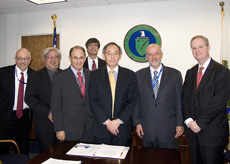 On Monday I attended my last meeting with Secretary Chu as member of the executive committee of the National Laboratories Directors Council (NLDC). Two of the members, Michael Anastasio, director of Los Alamos, and I, rotate out and two new members, Paul Hommert, director at Sandia and Paul Alivisatos, director of Berkeley, rotate in. The two remaining members are Sam Aronson, director of Brookhaven and Thom Mason, director of Oak Ridge, who takes over the chairmanship of the executive committee.
On Monday I attended my last meeting with Secretary Chu as member of the executive committee of the National Laboratories Directors Council (NLDC). Two of the members, Michael Anastasio, director of Los Alamos, and I, rotate out and two new members, Paul Hommert, director at Sandia and Paul Alivisatos, director of Berkeley, rotate in. The two remaining members are Sam Aronson, director of Brookhaven and Thom Mason, director of Oak Ridge, who takes over the chairmanship of the executive committee.
The NLDC was formed during Secretary Bodmans tenure as a mechanism for the Secretary to interact with the directors of the national laboratories across the broad front of issues that confront the laboratories and the DOE. The full NLDC meets about once a year and its executive committee either meets personally or on the phone with the Secretary on a monthly basis. Since its formation the NLDC has provided critical input to the Secretary on many proposed policies and requirements, making their application often simpler and more practical. These policies and requirements are often generated, with the best intentions, in the bowels of the DOE that are remote from the experience of actually running a laboratory. While several mechanisms exist at a lower level for the DOE to consult with the laboratories as new policies and requirements are developed, nothing works as effectively as closing the loop directly with the Secretary.
|
| Dec. 08, 2010 |
| Navigation |
|
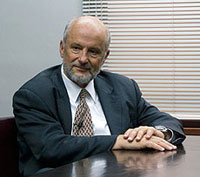 Somebody could get rich translating our adventures at Fermilab into a fast-paced video game called LAB. We have all the elements: a cast of creative and colorful personalities, the possibility of great discoveries, a semi-infinite set of rules to live by, multiple institutions ranging from our national and international partners to the DOE, Office of Management and Budget and Congress all trying to help us. We have a set of diverse activities in our site comparable to those of a small city. And besides all these, we have a great sense of suspense that comes both from the surprises that science serves us and from the dragons that jump out at us from the most unexpected places. Getting to the brass ring before "game over" is quite a challenge. While this might make for an exciting video game, though, it probably does not make for optimal management of a scientific enterprise.
Somebody could get rich translating our adventures at Fermilab into a fast-paced video game called LAB. We have all the elements: a cast of creative and colorful personalities, the possibility of great discoveries, a semi-infinite set of rules to live by, multiple institutions ranging from our national and international partners to the DOE, Office of Management and Budget and Congress all trying to help us. We have a set of diverse activities in our site comparable to those of a small city. And besides all these, we have a great sense of suspense that comes both from the surprises that science serves us and from the dragons that jump out at us from the most unexpected places. Getting to the brass ring before "game over" is quite a challenge. While this might make for an exciting video game, though, it probably does not make for optimal management of a scientific enterprise.
|
| Dec. 01, 2010 |
| Next Steps |
|
 The Voluntary Separation Offer closed on Monday, Nov. 29. Thirty-two employees volunteered, and we accepted 31 into the program. One group had more volunteers than could be accepted without harming the groups performance. While the number of volunteers is somewhat lower than we had expected, at this time we contemplate no further actions until we learn more about upcoming Congressional actions.
The Voluntary Separation Offer closed on Monday, Nov. 29. Thirty-two employees volunteered, and we accepted 31 into the program. One group had more volunteers than could be accepted without harming the groups performance. While the number of volunteers is somewhat lower than we had expected, at this time we contemplate no further actions until we learn more about upcoming Congressional actions.
The first Congressional action is needed before Dec. 3 when the present Continuing Resolution (CR) expires. Yesterday, the House prepared an extension of the CR to Dec. 18 that may come up for a vote before the end of the week. This would create a brief extension that hopefully will allow the President and Congressional leaders to agree on an overall legislative strategy to address several critical issues, including the ratification of the Strategic Arms Reduction Treaty (START), the extension of the tax cuts that expire at the end of this year and the FY2011 appropriation bills for the fiscal year that started last Oct. 1. During this short extension of the CR the Congress may pass an omnibus appropriations bill for FY2011, or, more likely, a year-long CR at the FY2010 enacted funding level. If there is no agreement before Dec. 18, the Congress is likely to extend the CR to February or March, kicking the can down the road and maintaining an unhealthy level of uncertainty for all science programs. There is no way to sugar coat the current situation.
|
| Nov. 23, 2010 |
| An eventful week |
|
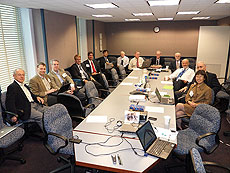 On Wednesday of last week we had a briefing for the DOE high energy physics program managers on Project X, preliminary to the process of determining mission need or CD0. This is the first hurdle we must pass to have a real project as we follow the DOE project management system. The group presenting Project X included folks from Fermilab, ANL and universities. Stan Wojcicki traveled from Stanford University, Doug Bryman from the University of British Columbia, and Yoshi Kuno from Osaka University to make presentations on the physics of neutrinos, kaons, and muons respectively. In addition to these physics presentations the briefing included my presentation on the overall strategy, Joe Lykken on the physics of the intensity frontier, Steve Holmes on Project X, and Jerry Nolen on the opportunities for fundamental measurement using nuclei and the use of Project X on energy issues. Project X gives us a very broad program that would be unmatched in the world at the intensity frontier and would give our nation a leadership position for decades to come.
On Wednesday of last week we had a briefing for the DOE high energy physics program managers on Project X, preliminary to the process of determining mission need or CD0. This is the first hurdle we must pass to have a real project as we follow the DOE project management system. The group presenting Project X included folks from Fermilab, ANL and universities. Stan Wojcicki traveled from Stanford University, Doug Bryman from the University of British Columbia, and Yoshi Kuno from Osaka University to make presentations on the physics of neutrinos, kaons, and muons respectively. In addition to these physics presentations the briefing included my presentation on the overall strategy, Joe Lykken on the physics of the intensity frontier, Steve Holmes on Project X, and Jerry Nolen on the opportunities for fundamental measurement using nuclei and the use of Project X on energy issues. Project X gives us a very broad program that would be unmatched in the world at the intensity frontier and would give our nation a leadership position for decades to come.
|
| Nov. 16, 2010 |
| Voluntary Separation Offer |
|
 Last week I announced a Voluntary Separation Offer. Whenever such an action is announced, it has the potential to affect morale and be discouraging. After all, we do have a full plate and we are making it harder to carry out our program by reducing the number of employees. It is natural to worry about what comes next. However, in reality, we should worry less about the future than if we had not taken this action.
Last week I announced a Voluntary Separation Offer. Whenever such an action is announced, it has the potential to affect morale and be discouraging. After all, we do have a full plate and we are making it harder to carry out our program by reducing the number of employees. It is natural to worry about what comes next. However, in reality, we should worry less about the future than if we had not taken this action.
By reducing the number of staff through a voluntary separation, we place the laboratory in a more resilient configuration. This is especially important when we are in a continuing resolution and we face uncertain times ahead. By taking this action now, we hope to avoid more difficult actions later in the year. The laboratory is doing extremely well, and we are delivering on our programs. We are developing a great set of experiments for the future at the most exciting time in particle physics in more than a decade. We continue to make the case that the nation needs to stay at the forefront of discovery, and Fermilab is an important part of staying at that frontier. Of course, in our system of budgeting there are no guarantees, and the Congress could surprise us.
|
| Nov. 11, 2010 |
| An important message from Director Pier Oddone |
|
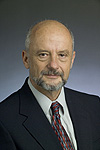 I am announcing today, November 11, a voluntary separation offer to bring Fermilab operations into balance with the resources we expect this fiscal year, FY11. The VSO is a financial package that the laboratory will offer to a subset of Fermilab employees in order to accomplish a necessary reduction in the size of the Fermilab staff.
I am announcing today, November 11, a voluntary separation offer to bring Fermilab operations into balance with the resources we expect this fiscal year, FY11. The VSO is a financial package that the laboratory will offer to a subset of Fermilab employees in order to accomplish a necessary reduction in the size of the Fermilab staff.
We are going into the new fiscal year with funding that is at best the same as last years, but without the benefit of the $10M carryover we were able to use in FY10. This creates a significant shortfall for the laboratory as a whole. We have reduced spending for materials and supplies as much as possible, but we still have a substantial gap in the funds for salaries, wages and benefits. To bring the funding into balance, we hope that up to 90 employees will take the opportunity afforded by the VSO. A website explaining the VSO includes a means to receive timely answers to your questions.
|
| Nov. 9, 2010 |
| A period of uncertainty |
|
 With the changes in the Congress following the mid-term election last week, we have an increased sense of uncertainty regarding our funding for FY 2011 and FY 2012, and hence greater uncertainties for the programs we are embarked on. Not that we are strangers to uncertainty. Even before the election, we did not have a budget for FY 2011, the fiscal year that started more than a month ago. At least, however, the Appropriations Committees of both the House of Representatives and the Senate had marked the Energy and Water Development Appropriations bill, and in normal times we could guess roughly where we would end up. The entire federal government is currently funded under a Continuing Resolution (CR) at mostly the FY 2010 enacted levels (excluding Recovery Act funding) through December 3. The end-game strategy being devised by the current Congress will require at least one extension of the CR.
With the changes in the Congress following the mid-term election last week, we have an increased sense of uncertainty regarding our funding for FY 2011 and FY 2012, and hence greater uncertainties for the programs we are embarked on. Not that we are strangers to uncertainty. Even before the election, we did not have a budget for FY 2011, the fiscal year that started more than a month ago. At least, however, the Appropriations Committees of both the House of Representatives and the Senate had marked the Energy and Water Development Appropriations bill, and in normal times we could guess roughly where we would end up. The entire federal government is currently funded under a Continuing Resolution (CR) at mostly the FY 2010 enacted levels (excluding Recovery Act funding) through December 3. The end-game strategy being devised by the current Congress will require at least one extension of the CR.
|
| Nov. 2, 2010 |
| HEPAP |
|
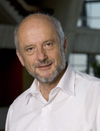 Last Tuesday, the High Energy Physics Advisory Panel met to consider the recommendations made by its P5 subpanel in connection with the proposed Tevatron extension. Professor Charlie Baltay, the chairman of P5, made a presentation on the reasons for the recommendations followed by discussions and a vote. HEPAP endorsed the P5 report and transmitted the recommendations to DOE. The conclusions of P5 are summarized in two recommendations:
Last Tuesday, the High Energy Physics Advisory Panel met to consider the recommendations made by its P5 subpanel in connection with the proposed Tevatron extension. Professor Charlie Baltay, the chairman of P5, made a presentation on the reasons for the recommendations followed by discussions and a vote. HEPAP endorsed the P5 report and transmitted the recommendations to DOE. The conclusions of P5 are summarized in two recommendations:
|
| Oct. 26, 2010 |
| US-Japan symposium |
|
 Last week from Wednesday through Friday I attended the symposium to celebrate 30 years of US-Japan collaboration under the US-Japan Agreement on High Energy Physics established in 1979. The agreement was part of the implementation of a broader collaboration on energy signed by President Carter and Prime Minister Fukuda. Notably entrepreneurial physicists like Leon Lederman, Pief Panofsky, Tetsuji Nishikawa, and program managers like Bill Wallenmeyer were quickly out of the gate with an implementing accord. Collaborations under the agreement are funded in different ways in Japan and the US. In Japan there is a fund set aside for these collaborations. Experiments are selected by the director of KEK with advice from a selection committee in response to proposals. These recommendations are reviewed and adjusted by the Joint Committee on the US-Japan Agreement composed of laboratory directors and agency program managers. In the US the collaboration is funded through regular channels in response to proposals to DOE.
Last week from Wednesday through Friday I attended the symposium to celebrate 30 years of US-Japan collaboration under the US-Japan Agreement on High Energy Physics established in 1979. The agreement was part of the implementation of a broader collaboration on energy signed by President Carter and Prime Minister Fukuda. Notably entrepreneurial physicists like Leon Lederman, Pief Panofsky, Tetsuji Nishikawa, and program managers like Bill Wallenmeyer were quickly out of the gate with an implementing accord. Collaborations under the agreement are funded in different ways in Japan and the US. In Japan there is a fund set aside for these collaborations. Experiments are selected by the director of KEK with advice from a selection committee in response to proposals. These recommendations are reviewed and adjusted by the Joint Committee on the US-Japan Agreement composed of laboratory directors and agency program managers. In the US the collaboration is funded through regular channels in response to proposals to DOE.
|
| Oct. 19, 2010 |
| An important week |
|
 Last week was notable for the FRA Board of Directors meeting on the 14 and 15 and the Particle Physics Project Prioritization Panel meeting on the 15 and 16.
Last week was notable for the FRA Board of Directors meeting on the 14 and 15 and the Particle Physics Project Prioritization Panel meeting on the 15 and 16.
We were fortunate to have both the DOE Director of the Office of Science, Bill Brinkman, and the Director General of CERN, Rolf Heuer, attend the FRA Board meeting. The discussions on the future of particle physics in the US, the CERN-Fermilab collaboration today and in the future, the plans for future global facilities and their governance were greatly enriched by Bill Brinkmans and Rolf Heuers participation. We are grateful that they took time from their overloaded schedules to come to Fermilab.
|
| Oct. 12, 2010 |
| A state of mind |
|
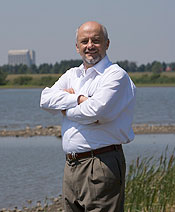 Among the important challenges Fermilab must meet in the next decade are a set of ambitious goals to reduce our emission of greenhouse gases, increase our energy efficiency, reduce potable water consumption, increase our use of renewable energy and incorporate sustainable practices in all major buildings and renovations. These goals are especially important to the Department of Energy in leading the way to a more sustainable world. As the laboratory with the largest consumption of electrical power among the DOE Office of Science laboratories we have a special responsibility to work towards these goals.
Among the important challenges Fermilab must meet in the next decade are a set of ambitious goals to reduce our emission of greenhouse gases, increase our energy efficiency, reduce potable water consumption, increase our use of renewable energy and incorporate sustainable practices in all major buildings and renovations. These goals are especially important to the Department of Energy in leading the way to a more sustainable world. As the laboratory with the largest consumption of electrical power among the DOE Office of Science laboratories we have a special responsibility to work towards these goals.
|
| Oct. 5, 2010 |
|
 We have started the new fiscal year. As is often the case, Congress has not passed the Energy and Water appropriations bill, so we are in a continuing resolution (CR) with spending that is fixed at last yearfs level and contains no funds for new starts. Because both LBNE and Mu2e were successful last year in obtaining CD-0, they are now considered gnew startsh in FY11, and their planned funding will not be available until Congress passes the FY11 Energy and Water appropriation bill. Because the CR was expected, the projects have made provisions to continue in R&D mode for the first part of the year and have the necessary resources to bridge the gap, provided the gap is not too long.
We have started the new fiscal year. As is often the case, Congress has not passed the Energy and Water appropriations bill, so we are in a continuing resolution (CR) with spending that is fixed at last yearfs level and contains no funds for new starts. Because both LBNE and Mu2e were successful last year in obtaining CD-0, they are now considered gnew startsh in FY11, and their planned funding will not be available until Congress passes the FY11 Energy and Water appropriation bill. Because the CR was expected, the projects have made provisions to continue in R&D mode for the first part of the year and have the necessary resources to bridge the gap, provided the gap is not too long.
|
| Sep. 21, 2010 |
| Tevatron |
|
 As described in my column of September 1, the Fermilab Physics Advisory Committee recommended a three-year extension for the Tevatron beyond FY11. We will proceed with the recommendation provided we can secure additional resources to continue running the Tevatron while minimizing damage to our Intensity Frontier experiments and avoiding damage to the national high energy physics program beyond Fermilab. Securing additional resources in the present funding climate is a tall order, and it will take some time. However, additional funding is absolutely essential for Tevatron operation beyond FY11. It is also important that we at Fermilab take responsibility for providing some of the needed resources out of our own hide.
As described in my column of September 1, the Fermilab Physics Advisory Committee recommended a three-year extension for the Tevatron beyond FY11. We will proceed with the recommendation provided we can secure additional resources to continue running the Tevatron while minimizing damage to our Intensity Frontier experiments and avoiding damage to the national high energy physics program beyond Fermilab. Securing additional resources in the present funding climate is a tall order, and it will take some time. However, additional funding is absolutely essential for Tevatron operation beyond FY11. It is also important that we at Fermilab take responsibility for providing some of the needed resources out of our own hide.
|
| Sep. 7, 2010 |
| Enthusiasm for physics |
|
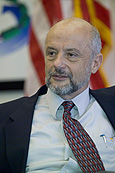 At the 48th International School for Subnuclear Physics in Erice, Italy, we had a terrific group of young scientists from all over the world who listened to lectures on both experimental and theoretical physics by old-timers like myself, Rolf Heuer, Sam Ting, Gerardus tHooft, Michael Duff and Sergio Ferrara, and not-so-old-timers like Raphael Bousso and Zvi Bern. The school is quite unusual in mixing the two disciplines, challenging experimentalists to understand the latest in N=8 supergravity or the gravitational S matrix, and challenging the theorist with the real world of experiments and their limitations and even such phenomena as the formation of bubbles in the COUPP bubble chamber. The young scientists not only listen to the talks but participate in extensive discussion sessions on each lecture, present their own individual research topics, prepare posters and, at the end, are graded by the panel of lecturers in a variety of categories, with prizes given to the top students based on their participation in all these activities. It is a good hunting ground for talent!
At the 48th International School for Subnuclear Physics in Erice, Italy, we had a terrific group of young scientists from all over the world who listened to lectures on both experimental and theoretical physics by old-timers like myself, Rolf Heuer, Sam Ting, Gerardus tHooft, Michael Duff and Sergio Ferrara, and not-so-old-timers like Raphael Bousso and Zvi Bern. The school is quite unusual in mixing the two disciplines, challenging experimentalists to understand the latest in N=8 supergravity or the gravitational S matrix, and challenging the theorist with the real world of experiments and their limitations and even such phenomena as the formation of bubbles in the COUPP bubble chamber. The young scientists not only listen to the talks but participate in extensive discussion sessions on each lecture, present their own individual research topics, prepare posters and, at the end, are graded by the panel of lecturers in a variety of categories, with prizes given to the top students based on their participation in all these activities. It is a good hunting ground for talent!
|
| Sep. 1, 2010 |
| Tevatron extension |
|
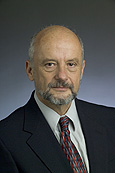 Last Friday we had a special meeting of the Physics Advisory Committee to address just one question: whether to recommend a proposed three-year extension of the Tevatron run. The Tevatron is now scheduled to close in September 2011.
Last Friday we had a special meeting of the Physics Advisory Committee to address just one question: whether to recommend a proposed three-year extension of the Tevatron run. The Tevatron is now scheduled to close in September 2011.
The PAC's recommendation was very strong. They recommended that we run the Tevatron in each of two proposed scenarios, one with additional funding in Fermilab's budget for Tevatron operations and one with no such extra funding. The committee's recommendation recognizes the extraordinary performance of the Tevatron and its remaining promise for the future. Extended running, combined with the predicted improvement in data analysis, would allow the Tevatron to make critical contributions to the discovery of the Higgs boson and our understanding of electroweak symmetry breaking. The combined potential of the Tevatron extension and early LHC running would constitute the optimal campaign to solve the central issue of particle physics. Many eminent members of the U.S. particle physics community have written to Secretary of Energy Steven Chu to express their support for more Tevatron running. The extension also motivates the collaborations to retain physicists and add new ones to carry out this program.
|
| Aug. 24, 2010 |
| Destination Fermilab |
|
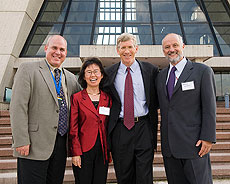 Last week we were very fortunate to have DOE Deputy Secretary Daniel Poneman visit the laboratory, accompanied by Bill Brinkman, director of the Office of Science. These visits by the leadership of the DOE are very important for us. When these managers make decisions about investments in particle physics research in competition with the many other demands for DOE investments, visits can make a big difference. There is no substitute for their having experienced the enthusiasm and professionalism of our staff, observed the facilities and the challenging activities we undertake, seen the flags flying in front of Wilson Hall that express our international role and understood the great asset that our site is for DOE.
Last week we were very fortunate to have DOE Deputy Secretary Daniel Poneman visit the laboratory, accompanied by Bill Brinkman, director of the Office of Science. These visits by the leadership of the DOE are very important for us. When these managers make decisions about investments in particle physics research in competition with the many other demands for DOE investments, visits can make a big difference. There is no substitute for their having experienced the enthusiasm and professionalism of our staff, observed the facilities and the challenging activities we undertake, seen the flags flying in front of Wilson Hall that express our international role and understood the great asset that our site is for DOE.
|
| Aug. 17, 2010 |
| Once in a decade |
|
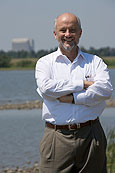 Last week the National Research Council unveiled the Decadal Survey of astronomy and astrophysics, New Worlds, New Horizons in Astronomy and Astrophysics. Professor Roger Blandford, who headed the survey for the last two years, presented the survey at a meeting held at the National Academy and webcast to many institutions around the world. The Decadal Survey is a remarkable enterprise of the astronomical and astrophysical communities. It occurs roughly every 10 years, with broad participation by the whole community. Its aim is to prioritize projects and programs for the decade ahead. The report was the culmination of two years of hard work involving five Science Frontier Panels to define the scientific themes, four Program Prioritization Panels that ranked research activities from space and from the ground, six Infrastructure Science Groups and, of course, the primary committee, the Committee for the Decadal Survey of Astronomy and Astrophysics of the National Research Council, which synthesized the final recommendations. In all there were 17 town hall meetings and more than 450 papers developed by the community on science, on projects and on infrastructure issues. If you get the picture that this was a massive enterprise, youve got it right!
Last week the National Research Council unveiled the Decadal Survey of astronomy and astrophysics, New Worlds, New Horizons in Astronomy and Astrophysics. Professor Roger Blandford, who headed the survey for the last two years, presented the survey at a meeting held at the National Academy and webcast to many institutions around the world. The Decadal Survey is a remarkable enterprise of the astronomical and astrophysical communities. It occurs roughly every 10 years, with broad participation by the whole community. Its aim is to prioritize projects and programs for the decade ahead. The report was the culmination of two years of hard work involving five Science Frontier Panels to define the scientific themes, four Program Prioritization Panels that ranked research activities from space and from the ground, six Infrastructure Science Groups and, of course, the primary committee, the Committee for the Decadal Survey of Astronomy and Astrophysics of the National Research Council, which synthesized the final recommendations. In all there were 17 town hall meetings and more than 450 papers developed by the community on science, on projects and on infrastructure issues. If you get the picture that this was a massive enterprise, youve got it right!
|
| Aug. 10, 2010 |
| Administrative review |
|
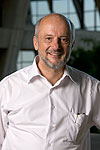 The FRA Board of Directors meets three times a year for two days. Six of its seven subcommittees (Physics, Strategy, Administration, ES&H, Audit and Compensation) meet the first day of the meetings in parallel sessions and kick the tires hard on their respective subjects. The seventh subcommittee of the board is the Executive Committee and it meets on a separate schedule. On the second day of the FRA board meetings, the board meets in full. One of the innovations in recent board meetings has been to tackle a couple of issues of importance for the laboratory both in break-out groups and with the whole board. This leads to valuable advice to the laboratory as the board members bring many perspectives to the table: that of academic, business and policy leaders. In addition to its own oversight through these meetings, the board also sets up two visiting peer review committees every year, one for the physics program and the second for reviewing the laboratory's administration.
The FRA Board of Directors meets three times a year for two days. Six of its seven subcommittees (Physics, Strategy, Administration, ES&H, Audit and Compensation) meet the first day of the meetings in parallel sessions and kick the tires hard on their respective subjects. The seventh subcommittee of the board is the Executive Committee and it meets on a separate schedule. On the second day of the FRA board meetings, the board meets in full. One of the innovations in recent board meetings has been to tackle a couple of issues of importance for the laboratory both in break-out groups and with the whole board. This leads to valuable advice to the laboratory as the board members bring many perspectives to the table: that of academic, business and policy leaders. In addition to its own oversight through these meetings, the board also sets up two visiting peer review committees every year, one for the physics program and the second for reviewing the laboratory's administration.
|
| Aug. 3, 2010 |
| CD-4 and my daughters wedding |
|
 Many of the DOE orders that we follow in our contract contain a prescriptive framework on how to deal with a variety of issues from health and safety to conduct of operations to project management. For those of us who deal with these orders day in and day out, it is all too easy to fit the world outside the laboratory to the same framework. Hence the title of this column on the DOE Project of Management Order 413.3 and my daughters wedding.
Many of the DOE orders that we follow in our contract contain a prescriptive framework on how to deal with a variety of issues from health and safety to conduct of operations to project management. For those of us who deal with these orders day in and day out, it is all too easy to fit the world outside the laboratory to the same framework. Hence the title of this column on the DOE Project of Management Order 413.3 and my daughters wedding.
For some the idea of carrying the framework outside the laboratory to our daily lives may appear to be a kind of mental disorder, some kind of post-DOE stress syndrome. But sometimes there are real advantages in doing so. For instance, the safety practices we adhere to in the laboratory have made many of my activities outside the laboratory considerably safer. More generally, when you apply the framework elsewhere you learn two things. The first is that it actually can be quite useful in the real world. The second is that, generally speaking, the framework is no more than good practices and common sense, albeit a kind of rigid common sense. But back to my daughters wedding
.
|
| July 20, 2010 |
| Projects |
|
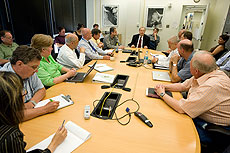 Last week we had a three-day Science and Technology Review in which a large fraction of our activities was reviewed by a committee of peers together with managers from the Department of Energy Office of High Energy Physics. The review went well. It is clear that the level of activity at the laboratory is huge and includes current programs, new projects and the continued running of the Tevatron. Given the overall strain in resources we are doing quite well and getting a lot done.
Last week we had a three-day Science and Technology Review in which a large fraction of our activities was reviewed by a committee of peers together with managers from the Department of Energy Office of High Energy Physics. The review went well. It is clear that the level of activity at the laboratory is huge and includes current programs, new projects and the continued running of the Tevatron. Given the overall strain in resources we are doing quite well and getting a lot done.
In connection with how we run projects and while he was at the laboratory for the review, Dennis Kovar, Associate Director for OHEP held a meeting with senior managers including division directors and project managers. It was a very useful exchange. Kovar explained what OHEP staff members see when they look at our projects, including how we handle the formalities required by the DOE Project Management Order 413.3, which also governs the critical decision process. The principles imbedded in the order are largely common sense, but there are a lot of formalities associated with the process that we need to manage accurately. The Office of Project Management Oversight can provide advice. Our project managers are gaining great experience as the drought of projects we have had during the last decade has ended. As we work on more projects, we'll be better able to take care of the formalities as we move forward.
|
| July 13, 2010 |
| Anniversary |
|
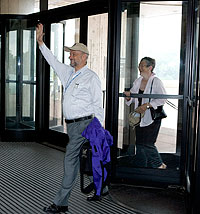 July 1 marked the completion of my first five years as director of Fermilab. It is a privilege to direct Fermilab, and I am pleased that the FRA Board of Director has now renewed my appointment for another term. As I look back at the last five years, in some ways time flies swiftly and I feel that I arrived here yesterday. In many respects, though, time appears expanded, and I feel I have been here forever. Perhaps this has to do with the feeling that anybody in particle physics haseven folks outside of Fermilabthat Fermilab is THEIR lab.
July 1 marked the completion of my first five years as director of Fermilab. It is a privilege to direct Fermilab, and I am pleased that the FRA Board of Director has now renewed my appointment for another term. As I look back at the last five years, in some ways time flies swiftly and I feel that I arrived here yesterday. In many respects, though, time appears expanded, and I feel I have been here forever. Perhaps this has to do with the feeling that anybody in particle physics haseven folks outside of Fermilabthat Fermilab is THEIR lab.
Certainly before I came here, Fermilab already felt familiar, and coming here was the most natural thing for a particle physicist to do, blurring the boundary between the before and after.
|
| July 6, 2010 |
| Engineering Manual |
|
 We are rolling out the Engineering Manual this week. We will hold a meeting to discuss the manual and its implementation this coming Thursday at noon in the auditorium. In the meantime, if you are involved in engineering at Fermilab, please pick up a hard copy of your manual in the duplicating area next to the east entrance of Wilson Hall. In the future the manual and its many appendices will be kept updated on the web.
We are rolling out the Engineering Manual this week. We will hold a meeting to discuss the manual and its implementation this coming Thursday at noon in the auditorium. In the meantime, if you are involved in engineering at Fermilab, please pick up a hard copy of your manual in the duplicating area next to the east entrance of Wilson Hall. In the future the manual and its many appendices will be kept updated on the web.
The manual comes from the effort of a group of engineers at Fermilab under the leadership of Paul Czarapata and Jay Theilacker. It has its origins in the root-cause analysis that we carried out after the failure of the internal supports of the LHC triplet magnets. The root-cause analysis pointed out several deficiencies in how we do reviews, in risk analysis and in documentation.
|
| June 29, 2010 |
| Persistent awareness |
|
 This year we have had an extraordinary record the lowest record ever of injuries.
This year we have had an extraordinary record the lowest record ever of injuries.
Last week the first accident that required work restrictions this fiscal year occurred. That incident was our first DART case for the year. This accident is once again a reminder that often accidents occur either at work or at home in the most ordinary of circumstances. In this case the cause was tripping while walking in the person's own office. Persistent awareness about how we interact with our surroundings is essential to maintaining safety at work and at home.
|
| June 23, 2010 |
| PAC |
|
 As we meet with the Program Advisory Committee in our yearly retreat to analyze and improve Fermilabs program, the first thing to celebrate is the continued remarkable performance of the Tevatron. Now with more than 2 inverse femtobarns for the year, we have broken the record for yearly accumulated luminosity. We have three weeks to go before the shutdown and hopefully another six weeks after the shutdown, so the record by the end of the fiscal year will be significantly higher than any previous record.
As we meet with the Program Advisory Committee in our yearly retreat to analyze and improve Fermilabs program, the first thing to celebrate is the continued remarkable performance of the Tevatron. Now with more than 2 inverse femtobarns for the year, we have broken the record for yearly accumulated luminosity. We have three weeks to go before the shutdown and hopefully another six weeks after the shutdown, so the record by the end of the fiscal year will be significantly higher than any previous record.
We have asked the PAC to comment on the value of continuing to run the Tevatron for an extended run of three years to improve the chances of discovery of the Higgs, anomalous CP violation and other topics beyond the Standard Model. Any decision to continue to run the Tevatron beyond its scheduled termination at the end of FY11 would affect how quickly we can develop our future programs. The threshold for changing our present plans is thus extraordinarily high and would involve many more players beyond Fermilab. That we are even discussing a possible running extension with the PAC is an homage to the folks who have produced such extraordinary performance out of the accelerator complex and tantalizing results from CDF and DZero.
|
| June 15, 2010 |
| Goings on in D.C. |
|
 Last week I spent three days in Washington D.C., all of them, as always, interesting, although they were also sobering.
Last week I spent three days in Washington D.C., all of them, as always, interesting, although they were also sobering.
On Tuesday I attended a day-long meeting with Secretary Steven Chu and all the lab directors. At the meeting we discussed many issues that cut across the Department of Energy laboratory system from strategy to sustainability to bureaucratic reform. Secretary Chu and Deputy Secretary Daniel Poneman are leading an effort to simplify and streamline the many requirements that DOE imposes on the laboratories, a formidable undertaking especially when the department today is called upon to act across many fronts. One such front is the oil spill in the Gulf. Secretary Chu is leading a technical group to advise the government and BP on technical issues, in particular rallying the DOE technical expertise to make quantitative measurements, modeling the geology and flows, anticipating what can go wrong in future actions and mitigating the risks. Much remains to be done in this area before the situation is brought under control.
|
| June 8, 2010 |
| The public and science |
|
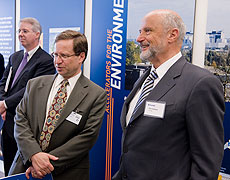 The Annual Users' Meeting was by all accounts a very successful event. Results, prizes and discussion about future plans were all part of the mix. Talks by Under Secretary for Science Steve Koonin, Associate Director for High Energy Physics Dennis Kovar and Congressman Bill Foster added an important Washington perspective. The public lecture by Under Secretary Koonin on the evening of June 2 was well attended by the public with some 700 participants from the surrounding community and schools.
The Annual Users' Meeting was by all accounts a very successful event. Results, prizes and discussion about future plans were all part of the mix. Talks by Under Secretary for Science Steve Koonin, Associate Director for High Energy Physics Dennis Kovar and Congressman Bill Foster added an important Washington perspective. The public lecture by Under Secretary Koonin on the evening of June 2 was well attended by the public with some 700 participants from the surrounding community and schools.
Under Secretary Koonin was very gracious to stay at Fermilab longer than he had planned, and at some personal inconvenience, to give the public lecture on energy. Secretary of Energy Steven Chu, who was originally scheduled to give the lecture, had to cancel his participation because he leads a large DOE technical team that is helping BP contain the run-away oil well in the Gulf. We are very appreciative of Under Secretary Koonins efforts and his excellent lecture, as were the many citizens who heard him. We also benefitted from his extended stay as he visited and talked with many folks at the laboratory about the scientific work we do here.
|
| June 1, 2010 |
| Results, results |
|
 Last week I gave the closing talk at the Brookhaven Forum 2010. At BF2010, over a period of two and half days, we got an excellent review of current results and a comprehensive description of the outlook for the next decade. Several scientists from Fermilab or associated with the Fermilab program gave excellent talks at the forum. Once again, Fermilab was the source of the results that folks talked about. We do live in a most interesting era.
Last week I gave the closing talk at the Brookhaven Forum 2010. At BF2010, over a period of two and half days, we got an excellent review of current results and a comprehensive description of the outlook for the next decade. Several scientists from Fermilab or associated with the Fermilab program gave excellent talks at the forum. Once again, Fermilab was the source of the results that folks talked about. We do live in a most interesting era.
Soon the LHC will open a huge new territory and much of the early new physics will be extremely exciting and maybe very hard to interpret. There is an almost endless variation in expectations from supersymmetric models, extra dimension theories, strong dynamics, Higgs models and so on. Many of these mimic each other (see Joe Lykkens talk at BF2010) and, to add to the chaos, the pressure on the experiments will lead to making statements of interesting physics early when the statistics are not yet completely conclusive. We are about to enter an era of absolutely enjoyable chaos and excitement.
|
| May 25, 2010 |
| At midyear |
|
 Yesterday, in a meeting that lasted several hours and took 175 slides, we presented an evaluation of our work, both scientific and operational, to our DOE site office. This presentation and the feedback we received from DOE is a mid-course look at the performance of the laboratory for FY2010. At the end of the year, the DOE Office of Science evaluation of the laboratory determines the fee that Fermi Research Alliance receives for managing the laboratory. More importantly, to gain an extension of our contract we must achieve a high rating for our performance. After last year's evaluation we became eligible for an extension of three years in our contract, through 2015. We are now in a phase of our contract when we are eligible for one year extension after each consecutive year of excellent performance for up to a total contract length of 20 years, which would take us to 2027.
Yesterday, in a meeting that lasted several hours and took 175 slides, we presented an evaluation of our work, both scientific and operational, to our DOE site office. This presentation and the feedback we received from DOE is a mid-course look at the performance of the laboratory for FY2010. At the end of the year, the DOE Office of Science evaluation of the laboratory determines the fee that Fermi Research Alliance receives for managing the laboratory. More importantly, to gain an extension of our contract we must achieve a high rating for our performance. After last year's evaluation we became eligible for an extension of three years in our contract, through 2015. We are now in a phase of our contract when we are eligible for one year extension after each consecutive year of excellent performance for up to a total contract length of 20 years, which would take us to 2027.
It is not easy to summarize 175 slides in a director's column, but the performance of the laboratory this year across the many criteria and the expected "notable outcomes" has been extraordinary and is due to all your efforts.
|
| May 11, 2010 |
| Last week |
|
 It is hard to think about writing anything else but reflections on the terrible events of last Thursday. We all share the shock and the sorrow of the death of Maria Beloyvan. She was a guest scientist at our laboratory from Russia, working on her Ph.D. degree in accelerator science.
It is hard to think about writing anything else but reflections on the terrible events of last Thursday. We all share the shock and the sorrow of the death of Maria Beloyvan. She was a guest scientist at our laboratory from Russia, working on her Ph.D. degree in accelerator science.
Whenever such an event takes place in the workplace, the ripples are wide-ranging still more so when the act occurs in our very midst. Our hearts go out to the family and close colleagues of Maria. But we are all affected, and over and over again we imagine what might have prevented such tragedy. What signs might have led to intervention; What could have been done that might have led to a different outcome? We probably will never know, as none of us can really understand the personal anguish that culminates in such a tragic act.
|
| May 4, 2010 |
| One lab. One system. |
|
 The laboratory is adopting a single electronic system for reporting time and effort. Its about time.
The laboratory is adopting a single electronic system for reporting time and effort. Its about time.
Every Fermilab employee will soon begin using a new version of Fermilab Time & Labor electronic reporting. The new timecard, produced by Kronos Inc., will allow employees to use a single interface to report time worked, leave taken and effort on specific projects and tasks. For monthly employees already using FTL, the process of reporting time and effort will remain largely unchanged, although the system will be new.
This month the FTL project team, led by the Computing Division, will begin providing training and guidance to all employees on how to use the new timecard system. Monthly employees, who have already been trained in electronic reporting, will receive group instruction on how to use the new timecard. Weekly employees will receive individualized training. Timekeepers and timecard approvers will receive training as well. Computing Division employees will visit divisions during the time they begin using the new timecard to provide assistance.
|
| April 27, 2010 |
| Balance II |
|
 In last weeks column I wrote about a question posed by Bill Brinkman, the Director of the Office of Science, to the lab directors on how to achieve balance between basic science and the urgent drive to address national energy and environmental needs. This weeks column looks at factors that affect the balance in a little more detail, in particular as they pertain to particle physics.
In last weeks column I wrote about a question posed by Bill Brinkman, the Director of the Office of Science, to the lab directors on how to achieve balance between basic science and the urgent drive to address national energy and environmental needs. This weeks column looks at factors that affect the balance in a little more detail, in particular as they pertain to particle physics.
Perceived opportunities and the cost to realize them: Many of the current difficulties in our field stem from the drive to position the U.S. to build the International Linear Collider by 2010, and the subsequent major change in direction after establishment of the ILC cost. The field passed over several opportunities at a smaller scale in the effort to aim all resources at the ILC. This made our field soft and vulnerable in the competitive environment of the Office of Science, especially with the delay in LHC results. The present plan, with a broader approach, multiple opportunities at a smaller scale and a significant accelerator R&D program that includes the ILC as one option, has received significant support both in the administration and Congress and may be more resilient.
|
| April 20, 2010 |
| Balance I |
|
 Last week I wrote about the first issue discussed at the April 7 Office of Science Lab Directors meeting: attracting the best and brightest to the DOE national laboratories. The second issue, much harder than the first, was a discussion on Director Brinkmans question: How can we achieve a balance between basic science and the urgent drive toward making contributions to the nations energy and environmental needs? The question is particularly relevant to particle physics, since we do not pretend to make direct contributions to energy or climate applications from the fundamental scientific questions we answer. We do develop technological spinoffs with wide applicability, but these are not necessarily predictable.
Last week I wrote about the first issue discussed at the April 7 Office of Science Lab Directors meeting: attracting the best and brightest to the DOE national laboratories. The second issue, much harder than the first, was a discussion on Director Brinkmans question: How can we achieve a balance between basic science and the urgent drive toward making contributions to the nations energy and environmental needs? The question is particularly relevant to particle physics, since we do not pretend to make direct contributions to energy or climate applications from the fundamental scientific questions we answer. We do develop technological spinoffs with wide applicability, but these are not necessarily predictable.
In the last 15 years, the balance has clearly changed: there has been a major shift in Office of Science research toward end-use inspired basic research that is directly relevant to energy, environment and new materials. From FY1996 to the FY2011 Presidents budget request, particle physics in the U.S. has suffered about a 15 percent drop in real terms compared with an increase of about 60 percent in real terms for the rest of the Office of Science. This trend to decrease basic research into fundamental questions relative to basic research aimed at applications could accelerate with the much-increased emphasis of this administration on energy and climate change.
|
| April 13, 2010 |
| Creating the right environment |
|
 A colleague of mine at Berkeley use to say that to attract the best scientists and engineers to the lab required us to to make the air right. The air was right if people coming to the laboratory found an atmosphere that supported their free inquiry, encouraged them to pursue scientific research wherever it took them, and allowed them to get things done with a minimum of fuss. Attracting the best and brightest to the national laboratories was one of the two topics that Bill Brinkman, Director of the DOE Office of Science, chose for discussion at the OS Lab Directors Meeting last week.
A colleague of mine at Berkeley use to say that to attract the best scientists and engineers to the lab required us to to make the air right. The air was right if people coming to the laboratory found an atmosphere that supported their free inquiry, encouraged them to pursue scientific research wherever it took them, and allowed them to get things done with a minimum of fuss. Attracting the best and brightest to the national laboratories was one of the two topics that Bill Brinkman, Director of the DOE Office of Science, chose for discussion at the OS Lab Directors Meeting last week.
One remarkable observation at the end of the discussion was that attracting the best and brightest to the national laboratories touched on almost every issue imaginable related to the management of the national laboratories. There was consensus on the attractors and barriers. Among the attractors we agreed on were:
|
| April 6, 2010 |
| National Lab Day |
|
 In an April 2009 speech to the National Academy of Science on the importance of science and science education to the nation, President Obama told the assembled scientists, "I want to persuade you to spend time in the classroom, talking and showing young people what it is that your work can mean, and what it means to you.... "
In an April 2009 speech to the National Academy of Science on the importance of science and science education to the nation, President Obama told the assembled scientists, "I want to persuade you to spend time in the classroom, talking and showing young people what it is that your work can mean, and what it means to you.... "
National Lab Day is a response to the President's call to action. National Lab Day is more than just a day. It's a nationwide initiative that will foster ongoing collaborations among volunteers, students and educators in a variety of on-going projects. We have the perfect mechanisms through our Education Office to make Fermilab count in this initiative.
At Fermilab, we are celebrating National Lab Day all week from May 3-7. I encourage Fermilab scientific and technical staff to contribute and volunteer time to this initiative during that week. The Education Office is coordinating Fermilab's volunteer participation in National Lab Day.
|
| Mar. 30, 2010 |
| Kudos! |
|
 With half of the fiscal year gone by, we have several records worth celebrating. The first is the new record in the Tevatron peak luminosity. It is quite remarkable that our accelerator team is still able to coax new records out of the collider and find improvements. The last record was quite significant: about a 7 percent increase over the previous record. So far this year we have accumulated 1.3 inverse femtobarns of data, well toward a record year with more than 2 inverse femtobarns, - provided we do not have some unexpected breakdown. The pace of publications in the archival literature continues with about half a dozen publications per month from the Tevatron on a rich variety of physics.
With half of the fiscal year gone by, we have several records worth celebrating. The first is the new record in the Tevatron peak luminosity. It is quite remarkable that our accelerator team is still able to coax new records out of the collider and find improvements. The last record was quite significant: about a 7 percent increase over the previous record. So far this year we have accumulated 1.3 inverse femtobarns of data, well toward a record year with more than 2 inverse femtobarns, - provided we do not have some unexpected breakdown. The pace of publications in the archival literature continues with about half a dozen publications per month from the Tevatron on a rich variety of physics.
The number of protons delivered on target for the MINOS experiment is also heading for a record, perhaps more than 3 x1020 protons on the neutrino target by the end of the run. New measurements on electron appearance should appear soon, as well as the results from the last several months of running in antineutrino mode. MiniBooNE continues to accumulate luminosity and should also have new results with an antineutrino beam, although the measure of their integrated protons-on-target is limited when the MINOS beam is running well.
|
| Mar. 23, 2010 |
| Visiting committee |
|
 During Thursday and Friday of last week the FRA Visiting Committee visited Fermilab to review our research program and the strategy for our future program. The FRA Board of Directors selected the committee, which reports to the Board. It comprises distinguished physicists from diverse areas of our field, including accelerators. This yearly independent review of our program and strategy by eminent folks in our field is part of the assurance that the FRA Board of Directors seeks to make sure we are fulfilling our scientific mission.
During Thursday and Friday of last week the FRA Visiting Committee visited Fermilab to review our research program and the strategy for our future program. The FRA Board of Directors selected the committee, which reports to the Board. It comprises distinguished physicists from diverse areas of our field, including accelerators. This yearly independent review of our program and strategy by eminent folks in our field is part of the assurance that the FRA Board of Directors seeks to make sure we are fulfilling our scientific mission.
This year the review was organized along the three frontiers of research at Fermilab. Because of time limitations, the review did not cover the Energy Frontier in full, leaving out detailed reports of the remarkable Tevatron performance and the great progress on the ILC R&D program at Fermilab. The review concentrated on the LHC and the development of the muon collider/neutrino factory R&D program. At the other two frontiers, the review was comprehensive.
|
| Mar. 9, 2010 |
| International Womens Day |
|
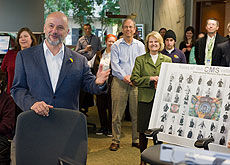 Yesterday marked the 100th anniversary of International Womens Day, a world-wide celebration of equal rights for women that we observed officially at Fermilab, as far as I am aware, for the first time this year. The origins of IWD go to the beginning of the 20th century when the treatment of women nearly everywhere showed great inequality and injustice. It was then only a few years after New Zealand in 1893 had become the first country to allow all women to vote, and it was nearly a decade before the passage of the Nineteenth Amendment to the United States Constitution establishing universal suffrage in our country.
Yesterday marked the 100th anniversary of International Womens Day, a world-wide celebration of equal rights for women that we observed officially at Fermilab, as far as I am aware, for the first time this year. The origins of IWD go to the beginning of the 20th century when the treatment of women nearly everywhere showed great inequality and injustice. It was then only a few years after New Zealand in 1893 had become the first country to allow all women to vote, and it was nearly a decade before the passage of the Nineteenth Amendment to the United States Constitution establishing universal suffrage in our country.
International Womens Day is not without controversy. In some environments, especially in developed countries, some see a special day to celebrate women as anachronistic: if women are treated equally, why do we need a special day? If we look at the world as a whole, however, there are powerful reasons both for celebrating how far we have come in establishing equality and justice in the workplace and showing our solidarity with the struggle of women in parts of the world where such equality and justice are still remote.
|
| Mar. 2, 2010 |
| ICFA and ILCSC |
|
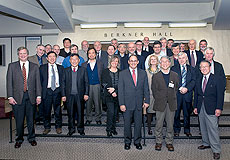 Last week at Brookhaven National Laboratory we had back-to-back meetings of the International Linear Collider Steering Committee, the ILCSC, and the International Committee for Future Accelerators, or ICFA. These periodic meetings bring together the directors of the principal laboratories devoted to particle physics across the world.
Last week at Brookhaven National Laboratory we had back-to-back meetings of the International Linear Collider Steering Committee, the ILCSC, and the International Committee for Future Accelerators, or ICFA. These periodic meetings bring together the directors of the principal laboratories devoted to particle physics across the world.
The ILCSC reviewed the status of the R&D and design of the ILC and associated detectors. Plans still call for completion of the technical design report, or TDR, in 2012, a year that promises to be a milepost for particle physics at the energy frontier. It is the first year after the planned completion of the Tevatron data runs, the year when the LHC will have obtained one inverse femtobarn at 7 TeV before shutting down to complete repair of all magnet interconnections, and the year when the ILC TDR will be ready for review by funding agencies. By then, the LHC will have opened a significant discovery wedge that could give a big boost to the ILC. It is doubtful, however, that only one inverse femtobarn of LHC data at 7 TeV could be the basis for a decision on the next machine at the energy frontier. More likely, we will need more data at the full energy of the LHC to make such a decision, probably around mid-decade. Nonetheless, discoveries in the next couple of years will give a strong hint on whether the ILC is likely to be the next machine at the energy frontier.
|
| Feb. 23, 2010 |
| Yearly budget review |
|
 Once a year in February we make a very extensive budget presentation to the DOE Office of High Energy Physics. Last week seven senior managers of the laboratory traveled to DC for a full day of presentations to Dennis Kovar, DOE associate director for HEP, and the managers of the various programs in his office. The presentations, contained in 190 slides, followed a prescribed format and described how the laboratory would adjust to and perform under three budget scenarios from now through 2016. These yearly presentations provide essential information for OHEP in preparing and defending the budget for the 2012 fiscal year and beyond.
Once a year in February we make a very extensive budget presentation to the DOE Office of High Energy Physics. Last week seven senior managers of the laboratory traveled to DC for a full day of presentations to Dennis Kovar, DOE associate director for HEP, and the managers of the various programs in his office. The presentations, contained in 190 slides, followed a prescribed format and described how the laboratory would adjust to and perform under three budget scenarios from now through 2016. These yearly presentations provide essential information for OHEP in preparing and defending the budget for the 2012 fiscal year and beyond.
This year our situation is much clearer than it was either last year or the year before. In 2008, we had severe budget cuts that led to furloughs and a voluntary separation program; and we did not know whether we would secure the needed supplemental funding to restore our programs. In 2009, the Congress had a continuing resolution through March at the disastrous level of funding of FY2008, and we did not know where the budget would finally settle. By contrast this year we received our FY2010 budget early in the fiscal year and the proposed Presidents budget for FY2011 is pretty much steady as she goes, with a 2.3 percent increase for HEP.
|
| Feb. 16, 2010 |
| National Engineers Week |
|
 This week, starting on Valentines Day and ending next Friday, we celebrate National Engineers Week. Here at Fermilab a series of activities, including lectures and tours of facilities opened to the Fermilab community, will honor and celebrate engineering. At Fermilab we have more than 200 engineers who transform physicists dreams into functioning equipment in multiple accelerators and detectors. They design and improve the supporting infrastructure, and help in diagnosing and repairing equipment during operations. Fermilab has an unmatched record in operating accelerators and detectors efficiently and safely, especially considering that ours are probably the most complex in the world. This performance is a testament to the superb engineering skills of our staff.
This week, starting on Valentines Day and ending next Friday, we celebrate National Engineers Week. Here at Fermilab a series of activities, including lectures and tours of facilities opened to the Fermilab community, will honor and celebrate engineering. At Fermilab we have more than 200 engineers who transform physicists dreams into functioning equipment in multiple accelerators and detectors. They design and improve the supporting infrastructure, and help in diagnosing and repairing equipment during operations. Fermilab has an unmatched record in operating accelerators and detectors efficiently and safely, especially considering that ours are probably the most complex in the world. This performance is a testament to the superb engineering skills of our staff.
This week will be the 20th celebration of National Engineers Week promoted by the foundation of the same name. During the week there will be many outreach activities to highlight the engineering profession and to introduce young people and the public to the wonders that engineering brings to the world. From the most dramatic large structures to the smallest structures in molecular engineering, engineers apply a combination of imagination and rigorous analytical skills to build all the things that have become essential to the economy and our well-being. However the profession is largely hidden in K-12 education, since unlike physics, chemistry or biology, engineering generally does not appear in the curriculum. The outreach that engineers perform, especially during Engineers Week but also throughout the year, is an essential service to the profession and the nation. There is hope that the situation is changing. Yesterday the New York Times reported on the newest Barbie Doll: an engineer!
|
| Feb. 9, 2010 |
| The issues of the week |
|
 Two issues dominated last week. The first arose from the decisions about the LHC that followed from the Chamonix meeting, affecting the LHCs running schedule, the accelerator repairs and plans for future upgrades. The second was the unveiling of the Presidents budget for FY2011.
Two issues dominated last week. The first arose from the decisions about the LHC that followed from the Chamonix meeting, affecting the LHCs running schedule, the accelerator repairs and plans for future upgrades. The second was the unveiling of the Presidents budget for FY2011.
The results of the Chamonix meeting were presented last Friday at CERN in a series of presentations culminating in Steve Myerss summary. The most important decision was to run the LHC at 7 TeV center-of-mass energy for about two years or one inverse femtobarn, whichever comes first. After that, the LHC would be shut down to fix a few thousand interconnections once and for all, a shutdown that would require at least a year.
|
| Feb. 2, 2010 |
| Visit to India: Part II |
|
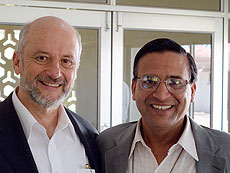 The Mumbai metropolitan area is the largest financial, industrial and commercial area in India, with more than 20 million inhabitants. Mumbai is also home to two of Indias premier physics institutions: the Tata Institute of Fundamental Research, TIFR, and the Bhabha Atomic Research Center, BARC. While in Mumbai we had the opportunity to meet with Dr. Anil Kakodkar, former secretary of the Department of Atomic Energy, the DAE, and Dr. Srikumar Banerjee, the current secretary of DAE and director of BARC.
The Mumbai metropolitan area is the largest financial, industrial and commercial area in India, with more than 20 million inhabitants. Mumbai is also home to two of Indias premier physics institutions: the Tata Institute of Fundamental Research, TIFR, and the Bhabha Atomic Research Center, BARC. While in Mumbai we had the opportunity to meet with Dr. Anil Kakodkar, former secretary of the Department of Atomic Energy, the DAE, and Dr. Srikumar Banerjee, the current secretary of DAE and director of BARC.
The meeting of the Funding Agencies for Large Colliders, FALC, took place at TIFR. Recently, FALC invited one director from the Americas region, me, and one director from Asian region, Atsuto Suzuki of KEK, to become members. The CERN director has been a member of FALC since its inception, as the representative of the small countries of Europe. These FALC meetings take place twice a year. The agencies inform each other on the state of particle physics in their respective countries and discuss how to coordinate their support of global projects. Even today the definition of global projects that require coordination by FALC is under discussion. At this stage, the only project on the horizon that is universally recognized as a global project is the International Linear Collidergenerally the main subject of discussions for FALC meetings. Recently some European colleagues have proposed considering the upgrade of the LHC as a global project. The discussion on that issue has only started.
|
| Jan. 26, 2010 |
| Visit to India: Part I |
|
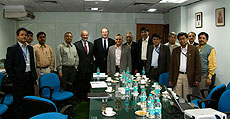 For the last 10 days, I visited our collaborators in India, met prospective new collaborators and altogether visited five Indian national laboratories. Our delegation consisted of myself; Dennis Kovar, the DOE Associate Director for High Energy Physics; and Shekhar Mishra, the Fermilab scientist who has been our ambassador and the main organizer of the collaboration with India. Jerry Blazey, NIU professor on leave to the DOEs Office of High Energy Physics, joined us for part of the visit. I also attended the meeting of FALC, the Funding Agencies for Large Colliders, which met in Mumbai on Jan. 17-18.
For the last 10 days, I visited our collaborators in India, met prospective new collaborators and altogether visited five Indian national laboratories. Our delegation consisted of myself; Dennis Kovar, the DOE Associate Director for High Energy Physics; and Shekhar Mishra, the Fermilab scientist who has been our ambassador and the main organizer of the collaboration with India. Jerry Blazey, NIU professor on leave to the DOEs Office of High Energy Physics, joined us for part of the visit. I also attended the meeting of FALC, the Funding Agencies for Large Colliders, which met in Mumbai on Jan. 17-18.
Indian institutions have been important participants in experimental programs throughout the history of Fermilab. In 2006 we added a major new collaboration for the development of superconducting linear accelerators, in particular for the development of technologies that are needed for Project X and for the ILC. Our immediate interest is in the development of high intensity proton accelerators, in particular, Project X. The construction of Project X will be greatly sped up if we can form a strong international collaboration for its construction, something that has not happened before in the construction of U.S. accelerators. Indian institutions are driven by their interest in developing high-intensity accelerators for neutron sources, for transmutation of radioactive waste and, someday, for driving thorium subcritical reactors that have multiple advantages for India, especially with the low availability of natural uranium resources within the country.
|
| Jan. 12, 2010 |
| Important milestones |
|
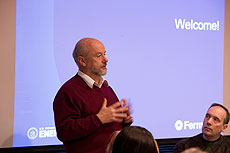 Several events last week were important for the laboratory. First came the approval of CD-0 for the Long Baseline Neutrino Experiment. Within the DOE project management system CD-0 is the first key decision and means the recognition of mission need. It signals the start of a project with the consequent serious planning by DOE for future years budgets. Of course, before projects can actually start construction, there are additional key decisions that will depend on our developing a satisfactory engineering design and cost within the parameters understood at CD-0. We have our work cut out for us.
Several events last week were important for the laboratory. First came the approval of CD-0 for the Long Baseline Neutrino Experiment. Within the DOE project management system CD-0 is the first key decision and means the recognition of mission need. It signals the start of a project with the consequent serious planning by DOE for future years budgets. Of course, before projects can actually start construction, there are additional key decisions that will depend on our developing a satisfactory engineering design and cost within the parameters understood at CD-0. We have our work cut out for us.
For this experiment we will create a new high intensity neutrino beam aimed at the NSF Deep Underground Science and Engineering Laboratory in the Homestake Mine in South Dakota. At the mine, collaboration between laboratories and universities funded by NSF and DOE will construct massive detectors to study neutrino physics. We also expect a strong international collaboration. In addition, these detectors will have capabilities to detect proton decay and supernova neutrinos. The combination of high intensity beams from Fermilab, the long baseline to Homestake and the massive detectors with multiple capabilities will create an absolutely world-class program.
|
| Jan. 5, 2010 |
| The start of a new year |
|
 We start the new year on a solid foundation. Despite many nagging hardware problems at the start of the current accelerator run, the accelerator performance over the last three months has been extraordinary, especially in recent days. A special kudos is due to all those who worked indefatigably over the holidays to run the accelerators at peak rates.
We start the new year on a solid foundation. Despite many nagging hardware problems at the start of the current accelerator run, the accelerator performance over the last three months has been extraordinary, especially in recent days. A special kudos is due to all those who worked indefatigably over the holidays to run the accelerators at peak rates.
The new year promises to be a critically important year for particle physics. The Fermilab Tevatron and neutrino programs will continue to integrate data samples that could lead to discoveries or important limits. We will have the first collisions of the LHC at 7 TeV, significantly above Tevatron energies. In a new territory like this, surprises could turn up even at the low early luminosities. JPARC is on the verge of sending a neutrino beam to Super Kamiokande thus starting the T2K program and the measurement of neutrino oscillation parameters with good sensitivity at the design intensity to the parameter that describes electron appearance. Reactor neutrino experiments are progressing well with new results expected in one to two years. These results will be critical for our own neutrino program. The tau-charm factory in Beijing is integrating an unprecedented large sample of events. On the astrophysics front, we expect new results in dark matter searches, a very hot topic these days. Very importantly, the Decadal Survey will establish astrophysics priorities for the next decade.
|
Director's Corner - Current Archive
2014 Director's Corner Archive
2013 Director's Corner Archive
2012 Director's Corner Archive
2011 Director's Corner Archive
2010 Director's Corner Archive
2009 Director's Corner Archive
Return to Current Fermilab Today
|
 The Fermilab spirit was very much in evidence last Friday. During the afternoon we had a symposium to celebrate the 25th anniversary of the first collisions at the Tevatron. It was an extraordinary experience to hear in one afternoon the rich history of the Tevatron and its many accomplishments. The Tevatron is the pioneering machine, the first large superconducting ring that broke new ground and set the stage for RHIC, HERA and the LHC. Its detectors, CDF and DZERO, are technological marvels and moved forward technologies like the use of silicon vertex detectors in hadronic collisions. The experimental collaborations made major discoveries and measurements of unprecedented precision. They produced hundreds of Ph.D. students and developed new analysis techniques. The remarkable thing about the Tevatron is that this rich history is not yet done as we are entering the new territory of electroweak symmetry breaking.
The Fermilab spirit was very much in evidence last Friday. During the afternoon we had a symposium to celebrate the 25th anniversary of the first collisions at the Tevatron. It was an extraordinary experience to hear in one afternoon the rich history of the Tevatron and its many accomplishments. The Tevatron is the pioneering machine, the first large superconducting ring that broke new ground and set the stage for RHIC, HERA and the LHC. Its detectors, CDF and DZERO, are technological marvels and moved forward technologies like the use of silicon vertex detectors in hadronic collisions. The experimental collaborations made major discoveries and measurements of unprecedented precision. They produced hundreds of Ph.D. students and developed new analysis techniques. The remarkable thing about the Tevatron is that this rich history is not yet done as we are entering the new territory of electroweak symmetry breaking. On Monday I attended my last meeting with Secretary Chu as member of the executive committee of the National Laboratories Directors Council (NLDC). Two of the members, Michael Anastasio, director of Los Alamos, and I, rotate out and two new members, Paul Hommert, director at Sandia and Paul Alivisatos, director of Berkeley, rotate in. The two remaining members are Sam Aronson, director of Brookhaven and Thom Mason, director of Oak Ridge, who takes over the chairmanship of the executive committee.
On Monday I attended my last meeting with Secretary Chu as member of the executive committee of the National Laboratories Directors Council (NLDC). Two of the members, Michael Anastasio, director of Los Alamos, and I, rotate out and two new members, Paul Hommert, director at Sandia and Paul Alivisatos, director of Berkeley, rotate in. The two remaining members are Sam Aronson, director of Brookhaven and Thom Mason, director of Oak Ridge, who takes over the chairmanship of the executive committee. Somebody could get rich translating our adventures at Fermilab into a fast-paced video game called LAB. We have all the elements: a cast of creative and colorful personalities, the possibility of great discoveries, a semi-infinite set of rules to live by, multiple institutions ranging from our national and international partners to the DOE, Office of Management and Budget and Congress all trying to help us. We have a set of diverse activities in our site comparable to those of a small city. And besides all these, we have a great sense of suspense that comes both from the surprises that science serves us and from the dragons that jump out at us from the most unexpected places. Getting to the brass ring before "game over" is quite a challenge. While this might make for an exciting video game, though, it probably does not make for optimal management of a scientific enterprise.
Somebody could get rich translating our adventures at Fermilab into a fast-paced video game called LAB. We have all the elements: a cast of creative and colorful personalities, the possibility of great discoveries, a semi-infinite set of rules to live by, multiple institutions ranging from our national and international partners to the DOE, Office of Management and Budget and Congress all trying to help us. We have a set of diverse activities in our site comparable to those of a small city. And besides all these, we have a great sense of suspense that comes both from the surprises that science serves us and from the dragons that jump out at us from the most unexpected places. Getting to the brass ring before "game over" is quite a challenge. While this might make for an exciting video game, though, it probably does not make for optimal management of a scientific enterprise. On Wednesday of last week we had a briefing for the DOE high energy physics program managers on Project X, preliminary to the process of determining mission need or CD0. This is the first hurdle we must pass to have a real project as we follow the DOE project management system. The group presenting Project X included folks from Fermilab, ANL and universities. Stan Wojcicki traveled from Stanford University, Doug Bryman from the University of British Columbia, and Yoshi Kuno from Osaka University to make presentations on the physics of neutrinos, kaons, and muons respectively. In addition to these physics presentations the briefing included my presentation on the overall strategy, Joe Lykken on the physics of the intensity frontier, Steve Holmes on Project X, and Jerry Nolen on the opportunities for fundamental measurement using nuclei and the use of Project X on energy issues. Project X gives us a very broad program that would be unmatched in the world at the intensity frontier and would give our nation a leadership position for decades to come.
On Wednesday of last week we had a briefing for the DOE high energy physics program managers on Project X, preliminary to the process of determining mission need or CD0. This is the first hurdle we must pass to have a real project as we follow the DOE project management system. The group presenting Project X included folks from Fermilab, ANL and universities. Stan Wojcicki traveled from Stanford University, Doug Bryman from the University of British Columbia, and Yoshi Kuno from Osaka University to make presentations on the physics of neutrinos, kaons, and muons respectively. In addition to these physics presentations the briefing included my presentation on the overall strategy, Joe Lykken on the physics of the intensity frontier, Steve Holmes on Project X, and Jerry Nolen on the opportunities for fundamental measurement using nuclei and the use of Project X on energy issues. Project X gives us a very broad program that would be unmatched in the world at the intensity frontier and would give our nation a leadership position for decades to come.  Last Tuesday, the High Energy Physics Advisory Panel met to consider the recommendations made by its P5 subpanel in connection with the proposed Tevatron extension. Professor Charlie Baltay, the chairman of P5, made a presentation on the reasons for the recommendations followed by discussions and a vote. HEPAP endorsed the P5 report and transmitted the recommendations to DOE. The conclusions of P5 are summarized in two recommendations:
Last Tuesday, the High Energy Physics Advisory Panel met to consider the recommendations made by its P5 subpanel in connection with the proposed Tevatron extension. Professor Charlie Baltay, the chairman of P5, made a presentation on the reasons for the recommendations followed by discussions and a vote. HEPAP endorsed the P5 report and transmitted the recommendations to DOE. The conclusions of P5 are summarized in two recommendations:  Last week from Wednesday through Friday I attended the symposium to celebrate 30 years of US-Japan collaboration under the US-Japan Agreement on High Energy Physics established in 1979. The agreement was part of the implementation of a broader collaboration on energy signed by President Carter and Prime Minister Fukuda. Notably entrepreneurial physicists like Leon Lederman, Pief Panofsky, Tetsuji Nishikawa, and program managers like Bill Wallenmeyer were quickly out of the gate with an implementing accord. Collaborations under the agreement are funded in different ways in Japan and the US. In Japan there is a fund set aside for these collaborations. Experiments are selected by the director of KEK with advice from a selection committee in response to proposals. These recommendations are reviewed and adjusted by the Joint Committee on the US-Japan Agreement composed of laboratory directors and agency program managers. In the US the collaboration is funded through regular channels in response to proposals to DOE.
Last week from Wednesday through Friday I attended the symposium to celebrate 30 years of US-Japan collaboration under the US-Japan Agreement on High Energy Physics established in 1979. The agreement was part of the implementation of a broader collaboration on energy signed by President Carter and Prime Minister Fukuda. Notably entrepreneurial physicists like Leon Lederman, Pief Panofsky, Tetsuji Nishikawa, and program managers like Bill Wallenmeyer were quickly out of the gate with an implementing accord. Collaborations under the agreement are funded in different ways in Japan and the US. In Japan there is a fund set aside for these collaborations. Experiments are selected by the director of KEK with advice from a selection committee in response to proposals. These recommendations are reviewed and adjusted by the Joint Committee on the US-Japan Agreement composed of laboratory directors and agency program managers. In the US the collaboration is funded through regular channels in response to proposals to DOE.  Among the important challenges Fermilab must meet in the next decade are a set of ambitious goals to reduce our emission of greenhouse gases, increase our energy efficiency, reduce potable water consumption, increase our use of renewable energy and incorporate sustainable practices in all major buildings and renovations. These goals are especially important to the Department of Energy in leading the way to a more sustainable world. As the laboratory with the largest consumption of electrical power among the DOE Office of Science laboratories we have a special responsibility to work towards these goals.
Among the important challenges Fermilab must meet in the next decade are a set of ambitious goals to reduce our emission of greenhouse gases, increase our energy efficiency, reduce potable water consumption, increase our use of renewable energy and incorporate sustainable practices in all major buildings and renovations. These goals are especially important to the Department of Energy in leading the way to a more sustainable world. As the laboratory with the largest consumption of electrical power among the DOE Office of Science laboratories we have a special responsibility to work towards these goals. At the 48th International School for Subnuclear Physics in Erice, Italy, we had a terrific group of young scientists from all over the world who listened to lectures on both experimental and theoretical physics by old-timers like myself, Rolf Heuer, Sam Ting, Gerardus tHooft, Michael Duff and Sergio Ferrara, and not-so-old-timers like Raphael Bousso and Zvi Bern. The school is quite unusual in mixing the two disciplines, challenging experimentalists to understand the latest in N=8 supergravity or the gravitational S matrix, and challenging the theorist with the real world of experiments and their limitations and even such phenomena as the formation of bubbles in the COUPP bubble chamber. The young scientists not only listen to the talks but participate in extensive discussion sessions on each lecture, present their own individual research topics, prepare posters and, at the end, are graded by the panel of lecturers in a variety of categories, with prizes given to the top students based on their participation in all these activities. It is a good hunting ground for talent!
At the 48th International School for Subnuclear Physics in Erice, Italy, we had a terrific group of young scientists from all over the world who listened to lectures on both experimental and theoretical physics by old-timers like myself, Rolf Heuer, Sam Ting, Gerardus tHooft, Michael Duff and Sergio Ferrara, and not-so-old-timers like Raphael Bousso and Zvi Bern. The school is quite unusual in mixing the two disciplines, challenging experimentalists to understand the latest in N=8 supergravity or the gravitational S matrix, and challenging the theorist with the real world of experiments and their limitations and even such phenomena as the formation of bubbles in the COUPP bubble chamber. The young scientists not only listen to the talks but participate in extensive discussion sessions on each lecture, present their own individual research topics, prepare posters and, at the end, are graded by the panel of lecturers in a variety of categories, with prizes given to the top students based on their participation in all these activities. It is a good hunting ground for talent! Last Friday we had a special meeting of the Physics Advisory Committee to address just one question: whether to recommend a proposed three-year extension of the Tevatron run. The Tevatron is now scheduled to close in September 2011.
Last Friday we had a special meeting of the Physics Advisory Committee to address just one question: whether to recommend a proposed three-year extension of the Tevatron run. The Tevatron is now scheduled to close in September 2011. Last week we were very fortunate to have DOE Deputy Secretary Daniel Poneman visit the laboratory, accompanied by Bill Brinkman, director of the Office of Science. These visits by the leadership of the DOE are very important for us. When these managers make decisions about investments in particle physics research in competition with the many other demands for DOE investments, visits can make a big difference. There is no substitute for their having experienced the enthusiasm and professionalism of our staff, observed the facilities and the challenging activities we undertake, seen the flags flying in front of Wilson Hall that express our international role and understood the great asset that our site is for DOE.
Last week we were very fortunate to have DOE Deputy Secretary Daniel Poneman visit the laboratory, accompanied by Bill Brinkman, director of the Office of Science. These visits by the leadership of the DOE are very important for us. When these managers make decisions about investments in particle physics research in competition with the many other demands for DOE investments, visits can make a big difference. There is no substitute for their having experienced the enthusiasm and professionalism of our staff, observed the facilities and the challenging activities we undertake, seen the flags flying in front of Wilson Hall that express our international role and understood the great asset that our site is for DOE.  Last week the National Research Council unveiled the Decadal Survey of astronomy and astrophysics, New Worlds, New Horizons in Astronomy and Astrophysics. Professor Roger Blandford, who headed the survey for the last two years, presented the survey at a meeting held at the National Academy and webcast to many institutions around the world. The Decadal Survey is a remarkable enterprise of the astronomical and astrophysical communities. It occurs roughly every 10 years, with broad participation by the whole community. Its aim is to prioritize projects and programs for the decade ahead. The report was the culmination of two years of hard work involving five Science Frontier Panels to define the scientific themes, four Program Prioritization Panels that ranked research activities from space and from the ground, six Infrastructure Science Groups and, of course, the primary committee, the Committee for the Decadal Survey of Astronomy and Astrophysics of the National Research Council, which synthesized the final recommendations. In all there were 17 town hall meetings and more than 450 papers developed by the community on science, on projects and on infrastructure issues. If you get the picture that this was a massive enterprise, youve got it right!
Last week the National Research Council unveiled the Decadal Survey of astronomy and astrophysics, New Worlds, New Horizons in Astronomy and Astrophysics. Professor Roger Blandford, who headed the survey for the last two years, presented the survey at a meeting held at the National Academy and webcast to many institutions around the world. The Decadal Survey is a remarkable enterprise of the astronomical and astrophysical communities. It occurs roughly every 10 years, with broad participation by the whole community. Its aim is to prioritize projects and programs for the decade ahead. The report was the culmination of two years of hard work involving five Science Frontier Panels to define the scientific themes, four Program Prioritization Panels that ranked research activities from space and from the ground, six Infrastructure Science Groups and, of course, the primary committee, the Committee for the Decadal Survey of Astronomy and Astrophysics of the National Research Council, which synthesized the final recommendations. In all there were 17 town hall meetings and more than 450 papers developed by the community on science, on projects and on infrastructure issues. If you get the picture that this was a massive enterprise, youve got it right! The FRA Board of Directors meets three times a year for two days. Six of its seven subcommittees (Physics, Strategy, Administration, ES&H, Audit and Compensation) meet the first day of the meetings in parallel sessions and kick the tires hard on their respective subjects. The seventh subcommittee of the board is the Executive Committee and it meets on a separate schedule. On the second day of the FRA board meetings, the board meets in full. One of the innovations in recent board meetings has been to tackle a couple of issues of importance for the laboratory both in break-out groups and with the whole board. This leads to valuable advice to the laboratory as the board members bring many perspectives to the table: that of academic, business and policy leaders. In addition to its own oversight through these meetings, the board also sets up two visiting peer review committees every year, one for the physics program and the second for reviewing the laboratory's administration.
The FRA Board of Directors meets three times a year for two days. Six of its seven subcommittees (Physics, Strategy, Administration, ES&H, Audit and Compensation) meet the first day of the meetings in parallel sessions and kick the tires hard on their respective subjects. The seventh subcommittee of the board is the Executive Committee and it meets on a separate schedule. On the second day of the FRA board meetings, the board meets in full. One of the innovations in recent board meetings has been to tackle a couple of issues of importance for the laboratory both in break-out groups and with the whole board. This leads to valuable advice to the laboratory as the board members bring many perspectives to the table: that of academic, business and policy leaders. In addition to its own oversight through these meetings, the board also sets up two visiting peer review committees every year, one for the physics program and the second for reviewing the laboratory's administration. Many of the DOE orders that we follow in our contract contain a prescriptive framework on how to deal with a variety of issues from health and safety to conduct of operations to project management. For those of us who deal with these orders day in and day out, it is all too easy to fit the world outside the laboratory to the same framework. Hence the title of this column on the DOE Project of Management Order 413.3 and my daughters wedding.
Many of the DOE orders that we follow in our contract contain a prescriptive framework on how to deal with a variety of issues from health and safety to conduct of operations to project management. For those of us who deal with these orders day in and day out, it is all too easy to fit the world outside the laboratory to the same framework. Hence the title of this column on the DOE Project of Management Order 413.3 and my daughters wedding. Last week we had a three-day Science and Technology Review in which a large fraction of our activities was reviewed by a committee of peers together with managers from the Department of Energy Office of High Energy Physics. The review went well. It is clear that the level of activity at the laboratory is huge and includes current programs, new projects and the continued running of the Tevatron. Given the overall strain in resources we are doing quite well and getting a lot done.
Last week we had a three-day Science and Technology Review in which a large fraction of our activities was reviewed by a committee of peers together with managers from the Department of Energy Office of High Energy Physics. The review went well. It is clear that the level of activity at the laboratory is huge and includes current programs, new projects and the continued running of the Tevatron. Given the overall strain in resources we are doing quite well and getting a lot done. July 1 marked the completion of my first five years as director of Fermilab. It is a privilege to direct Fermilab, and I am pleased that the FRA Board of Director has now renewed my appointment for another term. As I look back at the last five years, in some ways time flies swiftly and I feel that I arrived here yesterday. In many respects, though, time appears expanded, and I feel I have been here forever. Perhaps this has to do with the feeling that anybody in particle physics haseven folks outside of Fermilabthat Fermilab is THEIR lab.
July 1 marked the completion of my first five years as director of Fermilab. It is a privilege to direct Fermilab, and I am pleased that the FRA Board of Director has now renewed my appointment for another term. As I look back at the last five years, in some ways time flies swiftly and I feel that I arrived here yesterday. In many respects, though, time appears expanded, and I feel I have been here forever. Perhaps this has to do with the feeling that anybody in particle physics haseven folks outside of Fermilabthat Fermilab is THEIR lab. The Annual Users' Meeting was by all accounts a very successful event. Results, prizes and discussion about future plans were all part of the mix. Talks by Under Secretary for Science Steve Koonin, Associate Director for High Energy Physics Dennis Kovar and Congressman Bill Foster added an important Washington perspective. The public lecture by Under Secretary Koonin on the evening of June 2 was well attended by the public with some 700 participants from the surrounding community and schools.
The Annual Users' Meeting was by all accounts a very successful event. Results, prizes and discussion about future plans were all part of the mix. Talks by Under Secretary for Science Steve Koonin, Associate Director for High Energy Physics Dennis Kovar and Congressman Bill Foster added an important Washington perspective. The public lecture by Under Secretary Koonin on the evening of June 2 was well attended by the public with some 700 participants from the surrounding community and schools. Yesterday marked the 100th anniversary of International Womens Day, a world-wide celebration of equal rights for women that we observed officially at Fermilab, as far as I am aware, for the first time this year. The origins of IWD go to the beginning of the 20th century when the treatment of women nearly everywhere showed great inequality and injustice. It was then only a few years after New Zealand in 1893 had become the first country to allow all women to vote, and it was nearly a decade before the passage of the Nineteenth Amendment to the United States Constitution establishing universal suffrage in our country.
Yesterday marked the 100th anniversary of International Womens Day, a world-wide celebration of equal rights for women that we observed officially at Fermilab, as far as I am aware, for the first time this year. The origins of IWD go to the beginning of the 20th century when the treatment of women nearly everywhere showed great inequality and injustice. It was then only a few years after New Zealand in 1893 had become the first country to allow all women to vote, and it was nearly a decade before the passage of the Nineteenth Amendment to the United States Constitution establishing universal suffrage in our country.  Last week at Brookhaven National Laboratory we had back-to-back meetings of the International Linear Collider Steering Committee, the ILCSC, and the International Committee for Future Accelerators, or ICFA. These periodic meetings bring together the directors of the principal laboratories devoted to particle physics across the world.
Last week at Brookhaven National Laboratory we had back-to-back meetings of the International Linear Collider Steering Committee, the ILCSC, and the International Committee for Future Accelerators, or ICFA. These periodic meetings bring together the directors of the principal laboratories devoted to particle physics across the world.  The Mumbai metropolitan area is the largest financial, industrial and commercial area in India, with more than 20 million inhabitants. Mumbai is also home to two of Indias premier physics institutions: the Tata Institute of Fundamental Research, TIFR, and the Bhabha Atomic Research Center, BARC. While in Mumbai we had the opportunity to meet with Dr. Anil Kakodkar, former secretary of the Department of Atomic Energy, the DAE, and Dr. Srikumar Banerjee, the current secretary of DAE and director of BARC.
The Mumbai metropolitan area is the largest financial, industrial and commercial area in India, with more than 20 million inhabitants. Mumbai is also home to two of Indias premier physics institutions: the Tata Institute of Fundamental Research, TIFR, and the Bhabha Atomic Research Center, BARC. While in Mumbai we had the opportunity to meet with Dr. Anil Kakodkar, former secretary of the Department of Atomic Energy, the DAE, and Dr. Srikumar Banerjee, the current secretary of DAE and director of BARC.  For the last 10 days, I visited our collaborators in India, met prospective new collaborators and altogether visited five Indian national laboratories. Our delegation consisted of myself; Dennis Kovar, the DOE Associate Director for High Energy Physics; and Shekhar Mishra, the Fermilab scientist who has been our ambassador and the main organizer of the collaboration with India. Jerry Blazey, NIU professor on leave to the DOEs Office of High Energy Physics, joined us for part of the visit. I also attended the meeting of FALC, the Funding Agencies for Large Colliders, which met in Mumbai on Jan. 17-18.
For the last 10 days, I visited our collaborators in India, met prospective new collaborators and altogether visited five Indian national laboratories. Our delegation consisted of myself; Dennis Kovar, the DOE Associate Director for High Energy Physics; and Shekhar Mishra, the Fermilab scientist who has been our ambassador and the main organizer of the collaboration with India. Jerry Blazey, NIU professor on leave to the DOEs Office of High Energy Physics, joined us for part of the visit. I also attended the meeting of FALC, the Funding Agencies for Large Colliders, which met in Mumbai on Jan. 17-18.  Several events last week were important for the laboratory. First came the approval of CD-0 for the Long Baseline Neutrino Experiment. Within the DOE project management system CD-0 is the first key decision and means the recognition of mission need. It signals the start of a project with the consequent serious planning by DOE for future years budgets. Of course, before projects can actually start construction, there are additional key decisions that will depend on our developing a satisfactory engineering design and cost within the parameters understood at CD-0. We have our work cut out for us.
Several events last week were important for the laboratory. First came the approval of CD-0 for the Long Baseline Neutrino Experiment. Within the DOE project management system CD-0 is the first key decision and means the recognition of mission need. It signals the start of a project with the consequent serious planning by DOE for future years budgets. Of course, before projects can actually start construction, there are additional key decisions that will depend on our developing a satisfactory engineering design and cost within the parameters understood at CD-0. We have our work cut out for us.